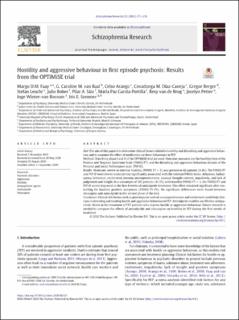| dc.contributor.author | Faay, Margo D.M. | |
| dc.contributor.author | van Baal, G. Caroline M. | |
| dc.contributor.author | Arango, Celso | |
| dc.contributor.author | Diaz-Caneja, Covadonga M. | |
| dc.contributor.author | Berger, Gregor | |
| dc.contributor.author | Leucht, Stefan | |
| dc.contributor.author | Bobes, Julio | |
| dc.contributor.author | Saiz, Pilar A. | |
| dc.contributor.author | García-Portilla, María Paz | |
| dc.contributor.author | van de Brug, Resy | |
| dc.contributor.author | Petter, Jocelyn | |
| dc.contributor.author | Winter-van Rossum, Inge | |
| dc.contributor.author | Sommer, Iris Else Clara | |
| dc.date.accessioned | 2021-07-16T12:31:31Z | |
| dc.date.available | 2021-07-16T12:31:31Z | |
| dc.date.created | 2020-09-28T12:48:14Z | |
| dc.date.issued | 2020 | |
| dc.identifier.issn | 0920-9964 | |
| dc.identifier.uri | https://hdl.handle.net/11250/2764698 | |
| dc.description.abstract | Aim: The aim of this paper is to determine clinical factors related to hostility and disturbing and aggressive behaviour and to examine the effect of medication on these behaviours in FEP.
Methods: Data from phase I and II of the OPTiMiSE trial are used. Outcome measures are the hostility item of the Positive and Negative Syndrome Scale (PANSS P7) and the disturbing and aggressive behaviour domain of the Personal and Social Performance scale (PSP-D).
Results: Moderate, severe or extreme hostility (PANSS P7 > 3) was present in 42 patients (9.4%). The PANSS P7 and PSP-D were low to moderate but significantly associated with the selected PANSS items: delusions, hallucinatory behaviour, excitement, tension, uncooperativeness, unusual thought content, impulsivity, and lack of judgement and insight. In a subsample of 185 patients (41.5%) with baseline PANSS P7 > 1, the PANSS P7 and PSP-D scores improved in the first 4 weeks of amisulpride treatment. This effect remained significant after controlling for baseline positive symptoms (PANSS P1-P6). No significant differences were found between olanzapine and amisulpride in the second phase of the trial.
Conclusion: Clinical risk factors such as poor impulse control, uncooperativeness and excitement could help clinicians in detecting and treating hostile and aggressive behaviour in FEP. Amisulpride could be an effective antipsychotic choice in the treatment of FEP patients who express hostile or aggressive behaviour. Future research is needed to compare the effects of amisulpride and olanzapine on hostility in FEP during the first weeks of treatment. | en_US |
| dc.language.iso | eng | en_US |
| dc.publisher | Elsevier | en_US |
| dc.rights | Navngivelse 4.0 Internasjonal | * |
| dc.rights.uri | http://creativecommons.org/licenses/by/4.0/deed.no | * |
| dc.title | Hostility and aggressive behaviour in first episode psychosis: Results from the OPTiMiSE trial | en_US |
| dc.type | Journal article | en_US |
| dc.type | Peer reviewed | en_US |
| dc.description.version | publishedVersion | en_US |
| dc.rights.holder | Copyright 2020 the authors | en_US |
| cristin.ispublished | true | |
| cristin.fulltext | original | |
| cristin.qualitycode | 2 | |
| dc.identifier.doi | 10.1016/j.schres.2020.08.021 | |
| dc.identifier.cristin | 1834208 | |
| dc.source.journal | Schizophrenia Research | en_US |
| dc.source.pagenumber | 271-278 | en_US |
| dc.identifier.citation | Schizophrenia Research. 2020, 223, 271-278. | en_US |
| dc.source.volume | 223 | en_US |

